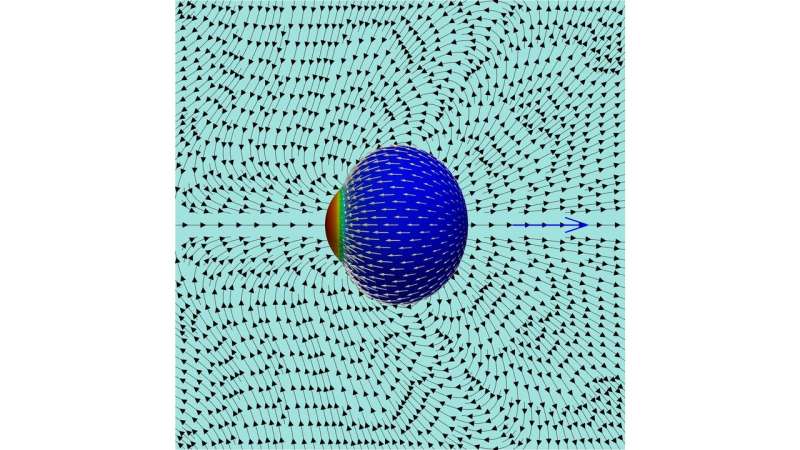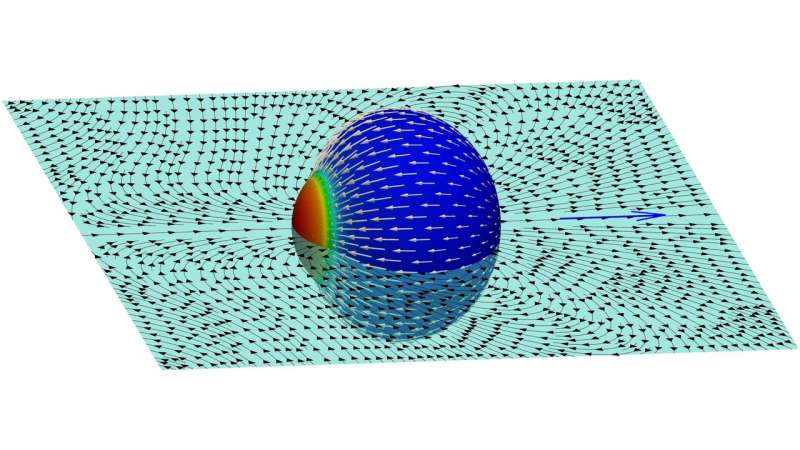October 1, 2019 feature
Studying a cell's crawling motion in a fluid

Cell motility, the spontaneous movement of cells from one location to another, plays a fundamental role in many biological processes, including immune responses and metastasis. Recent physics studies have gathered new evidence suggesting that mammalian cells do not only crawl on solid substrates, including complex 3-D mediums of a tissues, but can also swim in fluids.
In a recent study, a team of researchers at the University Grenoble Alpes and CNRS (National Center of Scientific Research) tried to shed light on the mechanisms behind the onset of motility cells in suspension, which would occur if they were moving in fluids. Their paper, published in Physical Review Letters, presents a model that couples actin and myosin kinetics with fluid flow, which they applied to a spherical and a non-spherical shape.
"Recent studies have suggested that adhesion is not necessary for cells to move in a three-dimensional environment, and have even shown that cells of the immune system can swim when suspended in a fluid," the researchers who conducted the study told Phys.org via email.
The motion of a cell through a tissue could be, at least to some extent, compared to its swimming movement in a gel composed of collagen filaments and interstitial fluid. This particular swimming motion, however, makes cells somewhat autonomous from a substratum, allowing them to navigate through any organ without having to adapt to alternating extracellular ligands, which would instead be required when crawling on a solid substratum.
The team at the University of Grenoble Alpes wanted to show that cells can swim in a fluid using the same or very similar mechanisms that they use when crawling on a solid. In addition, they wished to investigate the origin of this motility and uncover the feedback provided by the external medium to internal cell processes.
"Although we collaborated closely with several experimentalists to build up our insight on the problem and collected relevant orders of magnitude of the physical quantities we manipulate, our approach was mostly theoretical for this paper, and motivated by the observation that cells must efficiently navigate instead of being bound to a substrate (i.e., crawling)," the researchers said.
The cytoplasm of cells contains proteins called actins and myosins. Before a cell actually starts moving from one location to another, actin molecules self-assemble in a network along the cell membrane, known as 'cortex."

The cell model devised by the researchers has two key components: a gel of actin cortex and myosin motors. The myosin motors contract the actin gel, ultimately creating a flow of actin and myosin proteins towards areas with high myosin concentration. Eventually, this results in all myosin being concentrated in a single spot, with actin flowing towards it.
"This flow goes on perpetually, because new actin molecules are added at the opposite end of the cell," the researchers explained. "We have shown that cell acquires a spontaneous polarity (i.e., actin molecules are added at one pole and removed at the other end, in a sustainable manner). The flow of actin along the membrane grasps on the fluid outside to achieve cell propulsion and produces a complex flow pattern in the surrounding fluid."
The researchers observed that in this scenario, a cell's swimming speed resembles the speed that one would expect to see if it were crawling on a substrate. This is somewhat surprising, as walking is typically easier than swimming for living organisms. According to the researchers, this could be explained by the fact that the whole surface of the swimming cell concertedly participates in the propulsion.
"Depending on cell cortex renewal and contractility (two active properties which can be controlled by the cell either genetically or through specific biological pathways), we found that a cell can spontaneously polarize and start to move in a fluid," the researchers said. "It is also possible to obtain an oscillatory behaviour where the cell periodically changes direction."
The study offers fascinating new insight about the mechanisms behind the swimming motility of cells, or, as the researchers put it, their ability to crawl in a fluid. Their observations could be particularly useful for biologists who are trying to understand the motion of cells, as they imply that an individual cell can robustly move both in a fluid and along a solid substrate, utilizing the same mechanisms.
It is now known that immune cells and metastatic cells are confronted with vastly different environments as they migrate within an organism, yet the researchers found that the mechanisms they use to navigate these different environments might be very similar. Interestingly, the findings gathered in this work also suggest that a cell's speed is primarily set by the cortical viscosity, while external fluid viscosity is not relevant.
"With collaborators who perform experiments of suspended migrating cells, we aim at finding how cells may exploit the mechanisms we describe," the researchers said. "We also want to shed more light on the molecular details of how the cortex flow generates shear forces in the external medium, beyond the cell membrane. On the theoretical side, we believe that this model still has many possible variants which can yield interesting phenomena which would be relevant for a range of dynamics of actomyosin observed in living organisms."
More information: Alexander Farutin et al. Crawling in a Fluid, Physical Review Letters (2019). DOI: 10.1103/PhysRevLett.123.118101
Journal information: Physical Review Letters
© 2019 Science X Network




















